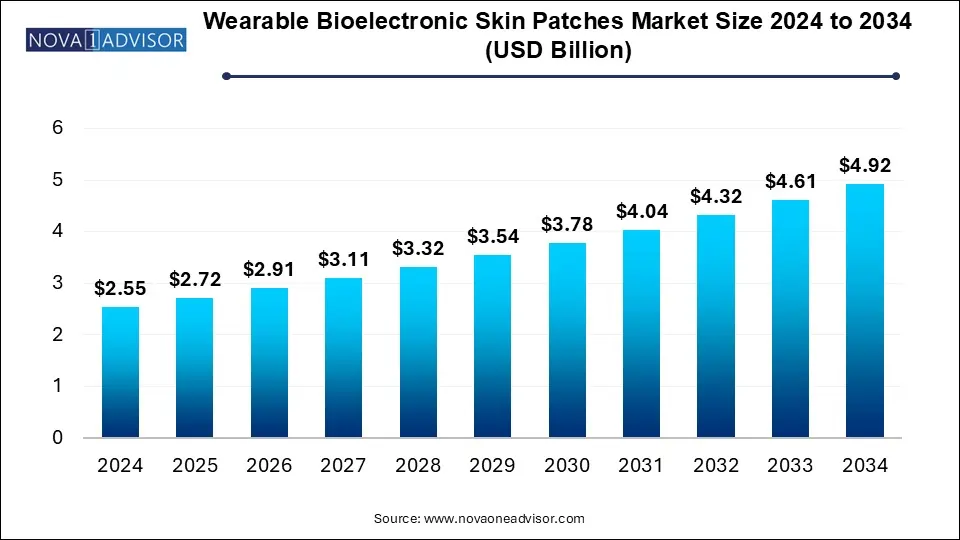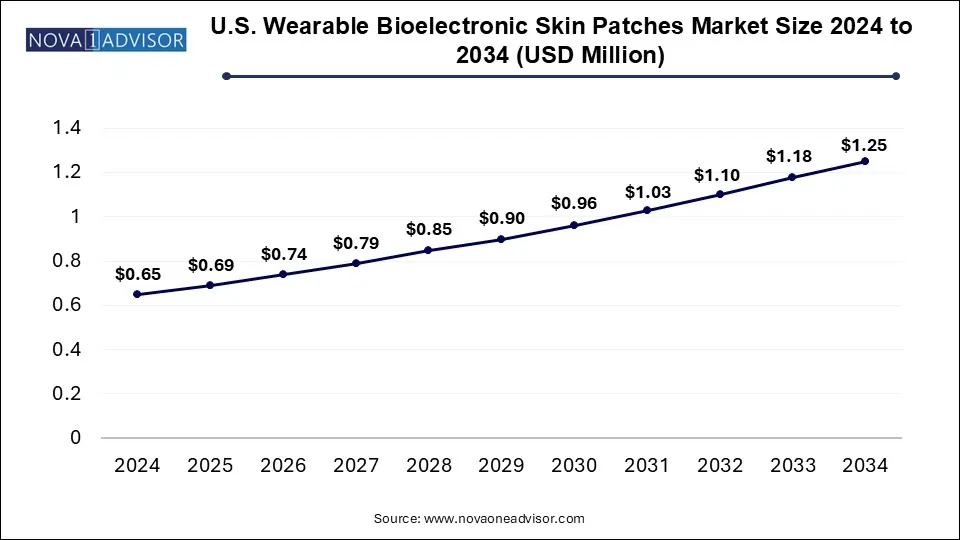The global wearable bioelectronics skin patches market size was valued at USD 2.55 billion in 2024 and is estimated to reach around USD 4.92 billion by 2034, exhibiting a compound annual growth rate (CAGR) of 6.8% during the forecast period 2025 to 2034.This growth is driven by rising demand for remote healthcare monitoring, advancements in flexible electronics, and increased consumer awareness of wearable health technologies.

The U.S. wearable bioelectronic skin patches market size was valued at USD 0.65 million in 2024 and is expected to reach around USD 1.25 million by 2034, growing at a CAGR of 6.12% from 2025 to 2034.

North America led the wearable bioelectronic skin patches market in 2024, due to its advanced healthcare infrastructure and high adoption of wearable health technologies. Strong investments in medical research, the existence of important industry players and growing awareness of personal health monitoring all contribute to its dominance. North Americas dominance of the market has also been strengthened by the rising demand for remote patient monitoring and the incorporation of AI in healthcare solutions.
Asia Pacific is witnessing the fastest growth, driven by a rising population, increasing healthcare awareness, and expanding telemedicine services. Increased demand for wearable medical technology as a result of government programs supporting digital health solutions and growing worries about lifestyle disease. Further propelling market expansion are the regions quickly changing technology sector and rising consumer interest in wellness and fitness.
Europe remains a key player in the market, with a strong focus on healthcare innovation and regulatory support for digital health solutions. In the region wearable bioelectronics have been actively incorporated into clinical procedures especially in the nations like France, Germany, and UK. Furthermore, the need for remote patient monitoring solutions has increased due to Europe's aging population making it an important market for future growth.
Wearable patches are becoming more and more popular among fitness enthusiasts and professional athletes for sweat analysis hydration monitoring and muscle activity tracking. These patches provide information about improving recovery and performance. Continuous glucose monitoring hypertension and cardiac conditions are all commonly monitored with wearable patches. The increasing use of wearable insulin delivery patches is another significant development.
Regulatory bodies like the FDA and European Medicines Agency (EMA) are promoting wearable health monitoring devices through fast tract approvals and funding initiatives. Governments are infrastructure, further propelling the market.
| Report Coverage | Details |
| Market Size in 2025 | USD 2.72 Billion |
| Market Size by 2034 | USD 4.92 Billion |
| Growth Rate From 2025 to 2034 | CAGR of 6.8% |
| Base Year | 2024 |
| Forecast Period | 2025-2034 |
| Segments Covered | Type, Application, End-use, Region |
| Market Analysis (Terms Used) | Value (US$ Million/Billion) or (Volume/Units) |
| Regional scope | North America; Europe; Asia Pacific; Latin America; MEA |
| Key Companies Profiled | 3M; Koninklijke Philips; GE Healthcare; MC10; Epicore Biosystems, Inc; iRhythm Technologies; Inc.; Insulet Corporation; The Surgical Company; ROTEX Global; Intelesens Ltd |
Market Dynamics
Drivers
Technological Advancements in Flexible Electronics
Electronic skin patches are now more effective lightweight stretchable and bioelectronics and smart materials. The efficiency and real time data transmission of these patches are further enhanced by advancements in wireless communication technologies (Bluetooth NFC and 5G)
Rising Demand for Remote Healthcare Monitoring
As chronic diseases like diabetes, heart disease and respiratory disorders become more common wearable electronic skin patches are becoming more and more popular. Frequent hospital visits are less necessary thanks to these devices which allow for continuous real-time monitoring of physiological parameters.
Market Opportunity
Growth in Geriatric Population
The aging population is more prone to chronic diseases, increasing the need for continuous health monitoring solutions. Wearable patches offer a non-invasive and user-friendly alternative to traditional diagnostic methods, making them highly suitable for elder patients.
Market Challenge
Regulatory and Data Privacy Concerns
Adherence to stringent regulations concerning patient privacy device approval and data security may impede market expansion. Because wearable technology gathers private health information it is susceptible to data breaches and cybersecurity risks. Expanding the market requires adherence to GDPR HIPAA and MDR (Medical Device Regulation EU)
Electrochemical sensors segment holds the largest share in 2024, driven by high sensitivity and accuracy in detecting various biomarkers. These sensors are favored by researchers and healthcare professionals due to their extensive use in medical diagnostics and health monitoring. They further solidify their market dominance by offering real-time data with little intrusion.
Temperature sensors segment is expected to grow at the fastest rate in the market during the forecast period driven by accurate and fast temperature readings which are essential for fitness and medical applications. As people's awareness of disease prevention and health monitoring grows these sensors are becoming a crucial component of smart wearables. Their ability to identify early signs of diseases like fever has increased their use in personal wellness and healthcare devices.
Home care settings segment holds the largest share driven by the increasing preference for remote health monitoring. These patches provide real time data without requiring frequent hospital visits which is helpful as more people look for easy noninvasive ways to monitor their health. With the ability to monitor vital signs from the comfort of their homes they are especially helpful in the management of chronic conditions like diabetes and cardiovascular diseases. The integration of wearable technology with mobile health applications and developments in telemedicine further support this expanding adoption.
Hospitals and clinics segment is growing the fastest due to the rising demand for continuous patient monitoring in critical care and post-surgical recovery. These patches are being used more and more by healthcare providers to monitor vital signs identify early symptoms ana analyze data in real time to improve patient outcomes. They are an important tool in contemporary medical settings because of their capacity to improve diagnostic accuracy and lower hospital readmission rates. Further wearable bioelectronic skin patches are becoming indispensable for remote patient management and customized treatment regimens as hospitals concentrate on implementing digital health solutions.
Fitness and wellness segment holds the largest share in 2024, in the wearable bioelectronic skin patches market, primarily due to the increasing consumer interest in personal health tracking. As more people prioritize leading active lives these patches aid in tracking important health indicators like heart rate hydration and muscle recovery. Their popularity among athletes and fitness enthusiasts has been further boosted by the incorporation of smart technology such as AI-driven insights and real time data tracking. Wearable patches are also a popular option for people looking for seamless health monitoring because they are more convenient than conventional fitness tracking devices.
Medical diagnostics segment is the fastest growing driven by the rising need for continuous health monitoring in both acute and chronic disease management. By providing real time noninvasive vital sign tracking these patches help detect conditions like diabetes respiratory issues and cardiovascular disease early. Their use in remote patient monitoring has grown in popularity particularly as telemedicine and home-based healthcare solutions become more widely used. As patients and healthcare professionals look for more dependable and effective diagnostic instruments wearable bioelectronic skin patches are quickly emerging as a crucial component of contemporary medical technology.
This report forecasts revenue growth at country levels and provides an analysis of the latest industry trends in each of the sub-segments from 2021 to 2034. For this study, Nova one advisor, Inc. has segmented the Wearable Bioelectronic Skin Patches Market
By Type
By Application
By End User
By Regional